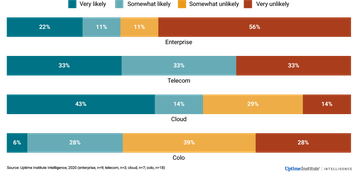A sector-wide focus on efficiency does not necessarily extend to many organizations’ centralized 3-phase uninterruptible power supply (UPS) systems. Today, these systems routinely achieve 94 percent to 96 percent efficiency in normal operational mode. Economy (eco) mode removes the double conversion process to enable higher levels of efficiency — up to 98 percent, typically.
In recent years, newer, high-efficiency operational modes that go beyond eco-mode have launched. In addition to normal operation (with the use of unconditioned power via the UPS bypass), newer UPS modes can actively manage power conversion by conditioning and supporting the output, but with reduced losses (all while maintaining the same level of power protection and the same level of battery backup).
Is efficiency worth the risk?
To better understand the requirements — and operator appetite — for newer, high-efficiency modes in the near future, Uptime Institute conducted in-depth interviews with 37 data center operators and their major engineering or operations partners, globally.
When asked about centralized 3-phase UPS systems that support only IT load (as opposed to those that support mechanical, or a mix of IT and mechanical), more than half (60 percent) of those in our study say they are unlikely to adopt newer, high-efficiency operational modes by 2025 (see Figure 1).
Among our study subjects, increased risk is the overwhelming barrier to adoption, particularly for colocation operators and their cloud clients. Newer, high-efficiency modes rely on a direct connection between input and output power terminals (via either a choke or switching device) to increase their efficiency — but this removes the galvanic isolation provided by double conversion, which means the load can be exposed to lightning or fast spikes and surges in voltage. Several colos say this lack of isolation is problematic for many of their customers. One European colo notes that even after factory demonstrations showing transfers between high-efficiency modes, clients still prefer full double conversion (normal operation).
A general reticence to being an early adopter of technology is also a factor for many in our study, as is concerns over limited vendor choice.
One respondent cites a low level of confidence in the promise of reliable power protection without voltage and frequency independent (VFI) and voltage independent (VI) modes. Another notes that numerous servers are sensitive to supply voltages and require a conditioned voltage source from UPS equipment. Their concern is that any IT server disruptions, including the loss of a server, may happen unnoticed, potentially severely impacting the business.
Among those interested in adopting the technology are cloud and telecom operators. They said cost efficiency is the primary driver, as are improved power usage effectiveness — PUE — and lower overall energy costs.
For broader adoption of newer, high-efficiency UPS operational modes that go beyond established eco-mode functions, it seems that manufacturers will need to do better to address concerns over risk.





